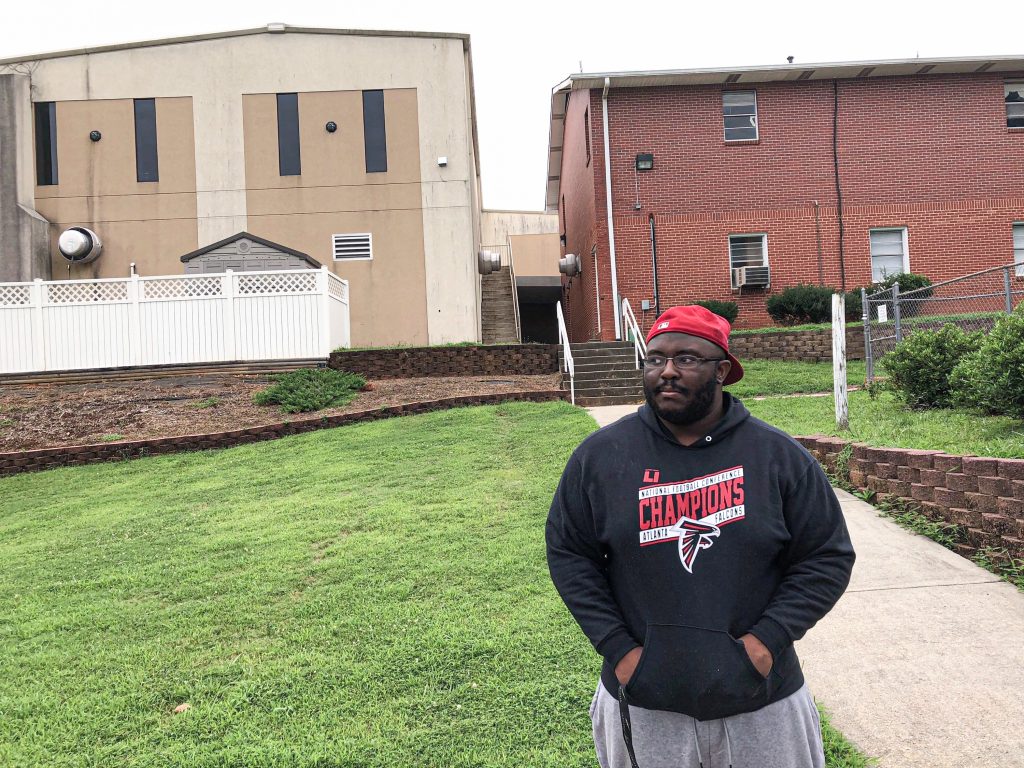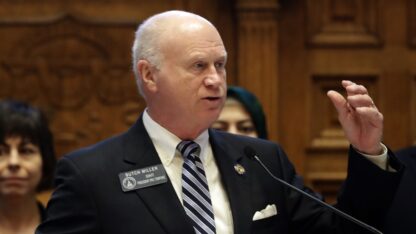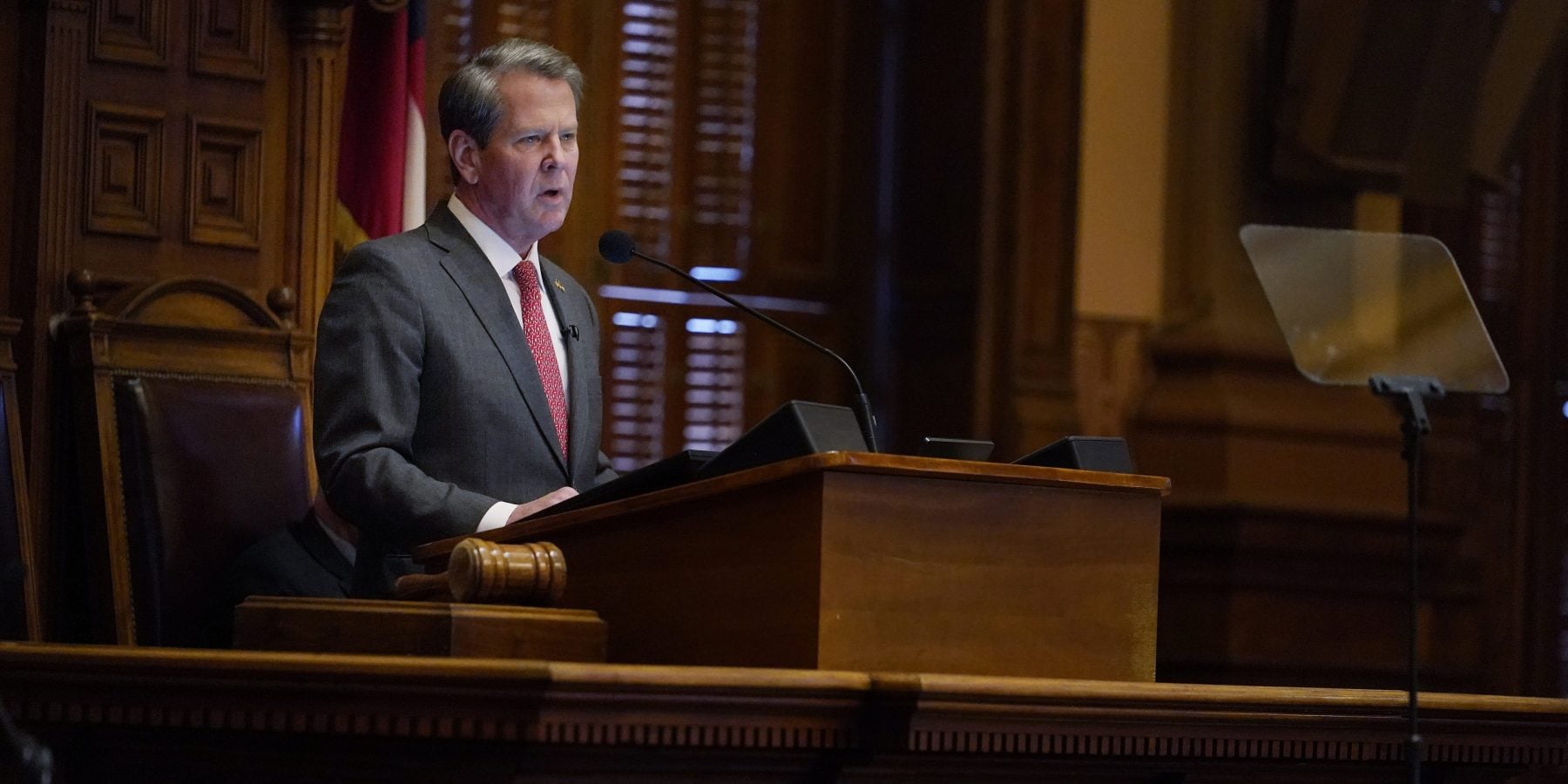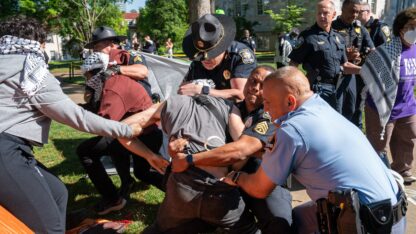How A Massive Voter Purge In Georgia Affected The 2018 Election

State officials claimed that people removed from the voter rolls for inactivity had likely died or moved away. But an APM Reports investigation found tens of thousands who hadn’t — and still wanted to vote.
Rachel Sender for APM Reports
This story — the second in a series on alleged voter suppression in Georgia — was reported in partnership with APM Reports.
On Election Day 2018, James Baiye II drove to Lucerne Baptist Church in the same suburban Atlanta neighborhood where he’d been registered to vote for most of his adult life. He dropped his brother and elderly mother at the front door, parked the car and got in line. Though he’d been registered for years, the 31-year-old African American hadn’t been a frequent voter. He’d spent a few years playing football at a junior college in North Carolina. In 2012, Baiye says, he requested an absentee ballot, but there’s no record of it in the state’s voter file. In fact, he hadn’t cast an in-person ballot since 2008, when Barack Obama first ran for president.
This year was different. He’d become excited about candidacy of Stacey Abrams, the Democrat who was vying to become Georgia’s first African-American governor, and the nation’s first-ever black woman to lead a U.S. state. It wasn’t Abrams’ race that swayed Baiye, he said, but rather her pledge to run the government differently. “A lot of being there for the people,” he said. “I just wanted to see her succeed.”
But when Baiye finally reached the front of the line, there was a problem. Poll workers couldn’t find his name on their list of registered voters. This was puzzling: Baiye is a citizen, he wasn’t a felon, and he hadn’t moved.
What Baiye didn’t know was he’d been caught up in one of the most hotly debated campaign issues in Georgia. It turned out that a year earlier Baiye had been removed from the voter rolls in a purge led by the office of Republican Secretary of State Brian Kemp, who was running for governor against Abrams.
On a single day in late July 2017, Kemp’s office had removed from the rolls 560,000 Georgians who had been flagged because they’d skipped one too many elections. Abrams would later call the purge the “use-it-or-lose-it scheme.” An APM Reports investigation last year estimated 107,000 of the people purged under the policy would otherwise have been eligible to vote last year, just like Baiye.
Georgia is one of a handful of states that removes people from the voter rolls for not turning out to vote in recent elections. Democrats and voting rights advocates have argued that just because someone chooses not to exercise their right to vote doesn’t mean they should be removed from the registration list. On the campaign trail, Kemp maintained that, in weeding out infrequent voters, he was safeguarding the election from fraud. Georgia officials have also argued that most of the people purged in 2017 had likely moved away or died.
But an APM Reports investigation has found that — contrary to those claims from state officials — 70,000 purged Georgians re-registered to vote. In a first-of-its-kind investigation, APM Reports used provisional ballots, registration and purge lists to piece together what happened to the Georgians who’d been scrubbed from the rolls. A majority — 65 percent — of those purged under “use it or lose it” who re-registered did so in the same county, meaning they would otherwise have been eligible to vote if not for the state’s aggressive purge policy.
The APM Reports investigation, the first to show significant impact from the “use it or lose it” policy, undermines the theory that it’s safe to assume that people who sit out multiple elections, or don’t make other contact with election officials, have likely moved or died. In Baiye’s case, nothing in his voter profile needed to be updated when he re-registered on Election Day, weeks after the state’s registration deadline. He still lives in the same house.
“They’re still in Georgia. They’re still alive,” said Emmet Bondurant, an Atlanta-based attorney who challenged Georgia’s purge law in federal court. Bondurant said the analysis is just more evidence that the state is using an overly broad formula that isn’t particularly accurate at identifying voters who should be cut because they’ve moved or died. “[They] were denied because of the excuse,” Bondurant said as he lowered his voice, and bounced his head from side to side, mocking supporters of the purges, “that we want to keep up-to-date rolls.”

Last year, the Supreme Court upheld the practice on a narrow 5-4 vote just months before the 2018 midterm elections. That paved the way for officials in Georgia and at least nine other states, most led by Republicans, to continue with the purges, which typically happen in each odd year after a federal election. More purges are planned in the coming months, ahead of the 2020 election, and they have the potential to knock hundreds of thousands from the rolls, helping to shape the electorate in some key battleground states, including Georgia and Ohio, for the coming presidential election.
But the purge laws are straightforward, proponents maintain, and they say voters have a responsibility to follow their state’s election rules. If they don’t heed warnings or respond to notices sent out by election officials, it’s their own fault, said Republican Lynn Westmoreland, a former member of Congress from Georgia who has worked on election policy throughout his career. “If they didn’t get to vote,” he added, “then they’ll get to vote in the next election.”
‘Ground zero’ for voter suppression
Baiye, a native Georgian who now does security work, heard all the chatter about voter suppression leading up to Election Day. In the final month of the campaign, voting rights advocates took Kemp to court over an “exact-match” policy that held up 53,000 pending registrations, mostly of people of color, many over small typos, like a missing apostrophe or hyphen. The prior month, all but two polling places in a rural, predominantly black county were targeted for closure. The county eventually backed off the poll closures, though a new plan has since resurfaced that would affect fewer black voters.
Disputes over those same policies arose in past decades when Georgia was still under federal oversight for its history of voter discrimination. The Justice Department objected to 177 election rule changes across Georgia — from limits on assisting illiterate voters, to redistricting and election schedule changes — between the late 1960s and 2012, agency records show. The Supreme Court lifted that oversight in 2013, in the seminal case, Shelby County v. Holder.
Last year, the U.S. Commission on Civil Rights reported that Georgia is the only state formerly under federal oversight to adopt all five of the most common voter suppression tactics: voter ID laws, proof of citizenship requirements, purges, cuts in early voting, and polling place closures.
Kemp and Abrams were adversaries over voting rights, and, in the campaign, they came to personify the debate between election security and access. In 2014, Kemp called for a criminal probe of registrations collected through the New Georgia Project, a nonprofit formed by Abrams, whose primary mission was to register new voters, particularly young adults and people of color.
Then, in July 2017, Kemp’s office removed 560,000 people from the voter rolls for infrequent voting. His office portrayed the purge as innocuous voter list maintenance, which secretaries of state regularly perform the year before an election. But the number of voters purged was unusually high. Some Democrats accused Kemp of trying to manipulate the electorate ahead of his run for governor.
By last November, Kemp and Abrams were embroiled in one of the most closely watched elections in the nation. Still, Baiye wasn’t sure what to make of the allegations that were flying. “[Y]ou hear about people going out of their way to cheat or manipulate the system,” he said, “and you think … these things aren’t real.”
But the 2017 purge likely gave an advantage to Kemp and other Republican candidates, an analysis of election results and state voter files shows. Purged voters were more likely to live in Democratic precincts, an APM Reports analysis found. Specifically, the data shows that, of the purged registrations that could be matched up to precincts, nearly 47 percent were from precincts that Abrams carried by more than 10 percentage points last November. (Those precincts made up just about 39 percent of overall votes.) Meanwhile, voters in strong Kemp precincts were under-represented on the purge list. Registrations from those heavily Republican precincts accounted for more than 43 percent of the purges. Such precincts made up over 51 percent of votes.
In competitive states like Georgia, even the smallest political advantage can change an election, said Lonna Atkenson, director of the Center for the Study of Voting, Elections, and Democracy at the University of New Mexico. It’s in these places that seemingly mundane issues like list maintenance or voter verification rules tend to be fiercely defended by incumbents. “[They’re] always worried about who is this going to tip the balance to,” Atkenson said.
Baiye’s county, Gwinnett, has become one of Georgia’s biggest political battlegrounds. It was carried by Mitt Romney in 2012 then flipped for Hillary Clinton in 2016, but Republicans still have a lot of power. The Justice Department chose Gwinnett as one of just 35 jurisdictions across the country to monitor last November for federal voting rights compliance.
On Election Day in 2018, Gwinnett County still saw numerous problems. Wait times remained some of the longest in the state, and poll workers, election observers and voters reported witnessing people being sent to multiple voting sites when they couldn’t be found on the list. Then there were equipment issues, like the power cords that election workers forgot to bring, which effectively shut down one polling place for hours.
‘What the heck is going on?’
After 15 or 20 minutes in line, Baiye showed his ID, and that’s when his effort to vote was derailed. When his name wasn’t found on the voter list, he was pulled aside and waited for another 30 to 45 minutes while poll workers kept trying to confirm that he was registered. At one point, he was quizzed about whether he might be a match with another person on the list, his uncle with a similar name. That uncle, who died months before, was still on the voter list. Baiye was not.
A poll worker agreed to allow Baiye to vote provisionally, meaning his vote would only be counted if it could later be verified as eligible. Across the state, more than 9,400 provisional ballots were cast by people who couldn’t be found on registration lists. The vast majority, nearly three out of every four, of those ballots were rejected, state records show.
A registration application was also included in Baiye’s ballot. He filled it out, but it was too late to make a difference this time around. Georgia has one of the least forgiving voter registration laws in the country; if voters don’t apply at least 29 days before an election, they can’t vote.
Across the state, at least 4,575 people who’d been purged went on to re-register in the same county but missed the registration deadline and weren’t allowed to vote, state voter records show.
Some of those purged voters who were locked out were likely Republicans. State data shows that a disproportionate number of people who were purged in 2017 and later reregistered on Election Day were white voters from solidly Republican rural counties. Many likely only discovered that they had been purged when they showed up at their polling place, and, because the registration deadline had passed weeks earlier, it was too late to do anything about it.
Experts say that’s not surprising, given that those areas were known for infrequent voting in past midterm elections. Kemp’s candidacy proved to be a draw, however, and “Operation Red Wall,” a Republican strategy aimed at rallying rural white voters, brought out more voters in some places last fall than Trump did two years prior.
Baiye, for one, was so frustrated by the process that he called a local radio station to vent. He also turned to social media where he discovered two friends were in the same situation.
“I wasn’t alone in this,” Baiye said, which caused him to wonder, “What the heck is going on?”

More purges on the horizon
Purges have been on the rise across the country in recent years, driven largely by southern states that were formerly under federal oversight because of voter discrimination. In the nine states, including Georgia, formerly subject to oversight, the purge rate (for all reasons excluding deaths) increased, on average, from 7 percent to 9 percent between 2015 and 2018, an analysis of a recent U.S. Election Assistance Commission survey shows. Meanwhile, rates in the rest of the country, on average, hovered around 6 percent.
In Georgia, other states, and even in Congress, the partisan divide over the purges hasn’t budged. Some Democrats are calling for Congress to ban purges for infrequent voting that would override state laws under HR1. Senate Republicans, however, have hinted that they’re not going to call a hearing on the measure.
In one of his first acts as governor, Kemp signed a reform bill in April that gives infrequent voters more time — nine years instead of seven — before their registrations are canceled. The bill also requires that voters receive an additional notice in the mail before they’re removed from the rolls.
This year, several states are preparing for another round of the purges under similar use-it-or-lose-it laws.
Oklahoma already removed more than 88,000 voters for similar inactivity in April. Ohio identified 235,000 people to cut from the voter rolls, but the list was narrowed after it was discovered that eligible voters were almost cut improperly. And in Georgia, state officials have put 315,000 inactive voters on notice that they will be purged if they don’t respond within 40 days.
Just how the purges guard against voter fraud is unknown, election experts say. A database of election fraud investigations compiled by the conservative Heritage Foundation identified just one case of voter fraud in the past two years among Oklahoma, Ohio and Georgia. That case involved the fraudulent use of an absentee ballot.
Evidence might be scant, but that hasn’t changed the minds of Republicans like Westmoreland. He argues that removing people from the registration list is a deterrent. “An up-to-date voter roll is, to me, [more likely] going to give you a purer election, than one that’s not,” he said.
Baiye sees it another way. The whole experience left him feeling like he got caught up in a “loophole” intended to discourage people like himself from voting. “It’s kind of mind blowing,” he said. “You’re basically saying if I don’t use my right, you’ll take my right away. That’s utterly ridiculous.”








